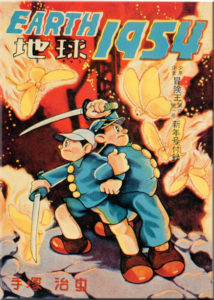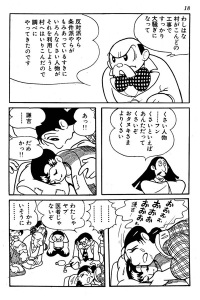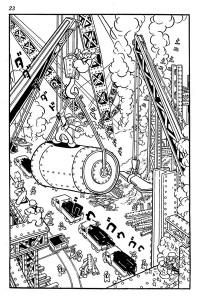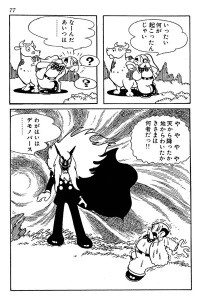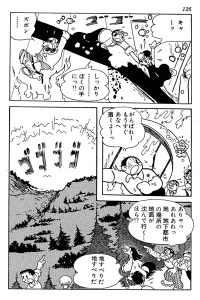Devil of the Earth, The (Manga)
also known as 地球の悪魔 | 地球1954 (Chikyu no Akuma | Chikyu 1954)
| English Title: | The Devil of the Earth Original Title: Earth 1954 |
| In English? | No |
| Japanese Title: | 地球の悪魔 (地球1954) Chikyu no Akuma (Chikyu 1954) |
| Type: | Supplement |
| Original run: | 1954/01 |
| Published in: | Adventure King 冒険王 |
| Published by: | Akita Shoten |
| Volumes: | 1 MT-009 |
Originally referred to as Earth 1954, Osamu Tezuka’s The Devil of the Earth (1954) first appeared as a New Year’s supplemental insert to Adventure King, in January 1954. It is one of six seasonal supplements Tezuka did for the periodical, including X-Point in the South Pacific (1953) and Lemon Kid (1953).
What it’s about
One day life in the peaceful little village known as Jusanri is disrupted by the sudden and unexplained appearance of a convoy of construction trucks. After a young boy named Kenkichi dies in a hit-and-run, the villagers’ amazement quickly turns to aggressive opposition.
Two years later, as Dr. Takano, the lead project engineer, enjoys a rare visit from his sister Sumiko. After the pair are attacked by a group of disgruntled villagers – including a pair of twin brothers, Eizo and Eiji who end up on opposite sides of the conflict – the purpose of the project becomes clear. It is a massive under ground bomb shelter designed to preserve human culture in the even of a nuclear war.
Meanwhile, while investigating suspicious activity reported in the area, Detective Shunsaku Ban discovers an international spy ring but is captured in the process. After a narrow escape from their clutches, Ban crosses paths with Sumiko and she introduces him to her brother. Although Ban warns Dr. Takano that he may be in danger – every prominent bomb designer has died from an apparent suicide, each leaving behind the same warning to “Beware Demonbasu” – but before he can finish, Dr. Takano is struck by a massive migraine.
After he recovers, he gives Detective Ban the guided tour of the amazingly high-tech underground facility, but the tour is interrupted by a mob of villagers that have been instigated to riot by the spies. Amidst the chaos, the mysterious Demonbasu appears and, after a frantic chase, Ban ends up trapped while he escapes.
Of course, before long events escalate and Dr. Takano is surprisingly revealed as Demonbasu – an alien being that has taken control of his brain as part of its plan to use humanity’s own super bombs against them. Yet, just when everything seems lost, a fire suddenly breaks out and destroys the entire complex.
In the aftermath, a suicide note reveals that although Dr. Takano had been acting under the influence of parasitic space invaders bent on humanity’s destruction, he himself had set the self-destruct sequence that saved the day.
However, after Ban pays a visits the local doctor, a fellow by the name Dr. Tezuka, he learns that x-rays of Dr. Takano’s head reveal that he had been suffering from the effects of a brain tumour all along… or was he?
What you should know
Drawn at a time when the nuclear arms race between the United States of American and the Soviet Union was in full swing, it should come as no surprise that The Devil of the Earth (1954) is another one of Tezuka’s manga works with an anti-war message – with a helping of poignant comments on the effects of mass construction and modernization on the side. Tezuka demonstrates this by having the idyllic quiet village life disrupted by an endless convoy of supply trucks, and an ultramodern underground city with the audacity to try and replace living creatures with robotic likenesses.
However, what is the real essence of the work is an exploration as to the true identity or nature of Demonbasu. Although for modern (and perhaps more jaded) readers, the double-back ending may not have quite the same impact it did on readers in 1954, it is still effective. Besides telling a relatively straightforward tale of a man whose dream crumbles down around him, Tezuka adds in another layer by having the mysterious Demonbasu revealed as Dr. Takano under the influence of “alien mind control” plot device. For most writers that would be enough, but for Tezuka it is one that he almost immediately reverses.
Instead, by introducing the added confusion of a wholly logical, medically-based, explanation (using himself as the exposition channel no less!) to reveal that Demonbasu is nothing more than the side effect of Dr. Takano’s brain tumour, Tezuka changes the point. Instead of an adequate story about a man who thinks big and crashes hard, first he gives the reader an “out” by explaining it all away as the result of an external controlling force… but then yanks that one out from under the reader and supplants it by a more logical one.
In the end, as is typical of many of Tezuka’s stories, he leaves it up to the reader to draw their own conclusions. If, for example, Demonbasu is simply the medical side-effect of Dr. Takano’s brain tumour, how does one explain the other suicide notes away? Are all great inventions with military applications simply the result of a malignant cerebral growth? Or, maybe there really ARE alien invaders… and that’s just what they want you to believe…
Stars Spotted:
- Rock Holmes as “Kenkichi”
- Shunsaku Ban as “Detective Shunsaku Ban”
- Daisuke as “the twin brothers, Eizo and Eiji Fukui”
- Notaarin as “Mr. Fukui”
- Noboru Baba as “the Tanuki monk”
- Osamu Tezuka as “Dr. Tezuka”
- Hamegg as “the crooked pachinko parlour owner”
- Madame Hell as “Ms. Sorge”
- Dr. Hanamaru as “Dr. Takano’s friend”

